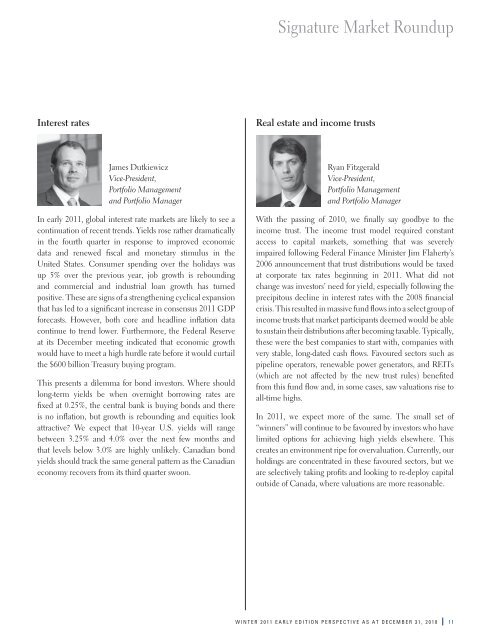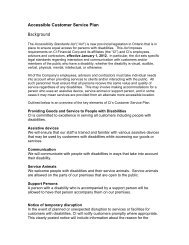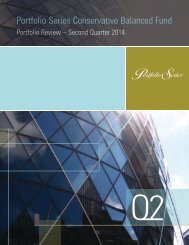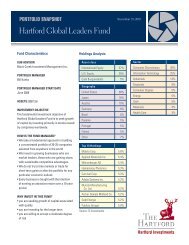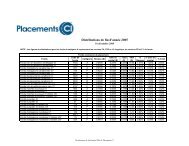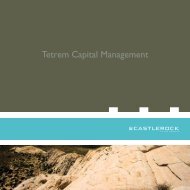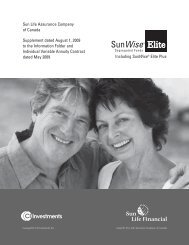Signature Market RoundupMarket RoundupGlobal outlookGlobal outlookEric BushellSenior Vice-President,Portfolio Managementand Chief Investment OfficerWe exited the third quarter believing that fears of a double-diprecession were overstated and that the bond market, wheredefensive investors had been hiding since the credit crisisbegan, had become fully valued. Since then, the U.S. FederalReserve took out added insurance in November against thepossibility of deflation by embarking on a US$60 billionTreasury purchase program. The dollar weakness associatedwith this second round of quantitative easing (or “QE2”)propelled commodities higher, led by gold, as printing of theworld’s reserve currency can have that effect. Moves higher foreconomically sensitive commodities like copper, oil and coalwere underpinned by real demand and supply disruptions. Inour diversified funds, we prefer to emphasize commoditieswith real uses ahead of gold. Inflation expectations have risenand global real interest rates have headed higher since QE2.In Europe, the temporary fund set up to ensure financialstability fund was made permanent as the European CentralBank pushed Ireland to become the first nation to accept abailout. Nonetheless, discussions over private sector losses ongovernment bonds and bank refinancing challenges elevatedconcerns among investors.The Republican victory in the U.S. mid-term elections wasgood news for business, which continued with the Obamaadministration’s agreement to extend Bush-era income taxcuts and add further tax incentives for business. We believethese measures will be effective in unlocking pent-up hiringand capital expenditure activity in coming quarters. Food andwage inflation pressures throughout developing economiesalso emerged in the fourth quarter, marking an end to theera of global disinflation. Overall, 2011 should see a recoveryin bank lending, consumption and business investment. Inshort, it should be a good year for global growth, and equitiesshould outperform as they did in 2010.Drummond BrodeurVice-President,Portfolio Managementand Global StategistThe outlook for global equity markets in 2011 is attractive.While many structural challenges remain – such as sovereigndebt in developed economies and rising inflation in emergingeconomies – our belief is that these issues will be trumped bythe unfolding cyclical recovery.All signs are that the U.S. economy has re-accelerated andshould continue to see strong private sector-led growth through2011, as companies invest and hire to meet growing demand.Meanwhile, policymakers have made it clear they will nottighten prematurely. The Federal Reserve remains committedto quantitative easing until June, while the necessary fiscalausterity has been deferred to 2012 at the earliest withthe extension of the Bush tax cuts and other measures tosupport employment.Many emerging economies have enjoyed robust recoveries andhave begun to tighten fiscal and monetary policy in response torising inflation. Nevertheless, we do not see this as a threat totheir still strong growth. While we believe Europe recognizesthe need to find solutions to its debt problems, we are less certainthat the same realization exists in the U.S., the world’s largestdebtor nation. The key challenge facing the global economy inthe next few years will be addressing the imbalances betweenthe U.S. and its creditors, led by China. We will be monitoringdevelopments as the world strives to develop a new set of rulesfor international economic engagement.10 WINTER 2011 EARLY EDITION PERSPECTIVE AS AT DECEMBER 31, 2010
Signature Market RoundupInterest ratesReal estate and income trustsJames DutkiewiczVice-President,Portfolio Managementand Portfolio ManagerIn early 2011, global interest rate markets are likely to see acontinuation of recent trends. Yields rose rather dramaticallyin the fourth quarter in response to improved economicdata and renewed fiscal and monetary stimulus in theUnited States. Consumer spending over the holidays wasup 5% over the previous year, job growth is reboundingand commercial and industrial loan growth has turnedpositive. These are signs of a strengthening cyclical expansionthat has led to a significant increase in consensus 2011 GDPforecasts. However, both core and headline inflation datacontinue to trend lower. Furthermore, the Federal Reserveat its December meeting indicated that economic growthwould have to meet a high hurdle rate before it would curtailthe $600 billion Treasury buying program.This presents a dilemma for bond investors. Where shouldlong-term yields be when overnight borrowing rates arefixed at 0.25%, the central bank is buying bonds and thereis no inflation, but growth is rebounding and equities lookattractive? We expect that 10-year U.S. yields will rangebetween 3.25% and 4.0% over the next few months andthat levels below 3.0% are highly unlikely. Canadian bondyields should track the same general pattern as the Canadianeconomy recovers from its third quarter swoon.Ryan FitzgeraldVice-President,Portfolio Managementand Portfolio ManagerWith the passing of 2010, we finally say goodbye to theincome trust. The income trust model required constantaccess to capital markets, something that was severelyimpaired following Federal Finance Minister Jim Flaherty’s2006 announcement that trust distributions would be taxedat corporate tax rates beginning in 2011. What did notchange was investors’ need for yield, especially following theprecipitous decline in interest rates with the 2008 financialcrisis. This resulted in massive fund flows into a select group ofincome trusts that market participants deemed would be ableto sustain their distributions after becoming taxable. Typically,these were the best companies to start with, companies withvery stable, long-dated cash flows. Favoured sectors such aspipeline operators, renewable power generators, and REITs(which are not affected by the new trust rules) benefitedfrom this fund flow and, in some cases, saw valuations rise toall-time highs.In 2011, we expect more of the same. The small set of“winners” will continue to be favoured by investors who havelimited options for achieving high yields elsewhere. Thiscreates an environment ripe for overvaluation. Currently, ourholdings are concentrated in these favoured sectors, but weare selectively taking profits and looking to re-deploy capitaloutside of Canada, where valuations are more reasonable.WINTER 2011 EARLY EDITION PERSPECTIVE AS AT DECEMBER 31, 2010 11


